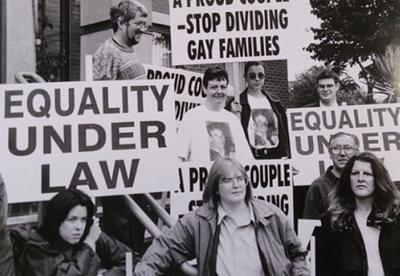Stand Up and Speak Out! LGBTQ+ Activism and Protest in Birmingham
ResourcesThis is a KS3 lesson on Birmingham’s local LGBTQ+ history which uses objects and images from Birmingham Museum Trust’s collections. In this lesson, students will learn about LGBTQ+ activism in Birmingham and how the aims and objectives of activists have changed over time.
Links to the KS3 History Curriculum
- Identifying significant events, making connections, drawing contrasts, and analysing trends within periods and over long arcs of time
- Challenges for Britain, Europe and the wider world 1901 to the present day, including social, cultural and technological change in post-war British society
- Local history study
Sources and background notes for teachers
See the Birmingham LGBTQ+ timeline for more information on the history of Birmingham’s LGBTQ+ community.
Photograph of a UNISON protest

This photograph was taken in the early 1990s. It shows a protest in support of LGBTQ+ rights which was organised by the trade union UNISON.
Unison is a trade union which supports the welfare of workers in the public service industries. It also supports and campaigns for broader civil liberties and human rights which are not directly related to workplace disputes.
Unison organised campaigns and protests in Birmingham throughout the 1980s and 1990s in support of issues including LGBTQ+ rights, disability rights and anti-racism.
Throughout the 1990s, LGBTQ+ people campaigned for equality and protection from discrimination under UK law.
UNMUTED Banners for Birmingham Pride


These banners were designed by the group UNMUTED and used at Birmingham Pride in May 2017.
UNMUTED provides a support network for LGBTQ+ people of colour in Birmingham, who continue to face a lack of visibility and representation in the wider LGBTQ+ community.
They want to draw attention to the complex issues faced by LGBTQ+ people of colour, including racism, the intersection between faith and LGBTQ+ identity and the unique challenges faced by trans people in the BAME LGBTQ+ community.
Activities
Activity Suggestions
Starter Activity
Share a definition of activism with your class and give them an example of activism. Ask your class to suggest some examples of activism they have seen or heard about in the news. Mindmap their ideas on the board.
Main Activity
Introduce the topic of LGBTQ+ activism in Birmingham and show students the Birmingham LGBTQ+ History timeline. Tell the students we are going to be looking at some sources.
Print out the source images on a blank sheet of paper and hand these out to your class.
Ask your students to make notes around the images. They should note down their first impressions of what the sources suggest about LGBTQ+ activism in Birmingham.
Questions to guide student analysis:
- Looking at these images, what issues do you think the activists using these banners were concerned about and what changes did they want to achieve?
- Look at the slogans on the protest banners. What are the campaigners trying to say?
- You may want to point out that the symbol of the closed fist on the ‘We Exist’ banner is the symbol of the Black Lives Matter Movement. Here it has been printed with the rainbow colours of the LGBTQ+ pride flag.
- You may also want to define the term Queer. See the Stonewall website for a list of terms used by the LGBTQ+ community.
- Share the information about the images with your students. Ask them to use a different colour pen to annotate the sources again, in light of the source knowledge you’ve shared with them.
Once the class have shared their ideas, ask the enquiry question below:
What do these sources tell us about how the aims and concerns of Birmingham LGBTQ+ activists have changed between the 1990s and the present?
Stretch Activity
Look at this definition of the term ‘intersectionality’ by US lawyer and civil rights advocate, Kimberlé Crenshaw:
It’s basically a lens, a prism, for seeing the way in which various forms of inequality often operate together and exacerbate each other. We tend to talk about race inequality as separate from inequality based on gender, class, sexuality or immigrant status. What’s often missing is how some people are subject to all of these, and the experience is not just the sum of its parts.*
Look again at the UNMUTED banners. How do you think we can see intersectionality in the aims and concerns of the UNMUTED campaigners?
Plenary Activity
Ask your students to think of a question they have about LGBTQ+ activism in Birmingham. Get them to write their question on a post-it and stick it on the board. Take a picture of their questions and tag us on Twitter @bmtlearning.
* Steinmetz, K. (2020, February 20) Kimberlé Crenshaw: “She Coined the Term ‘Intersectionality’ Over 30 Years Ago. Here’s What It Means to Her Today”. TIME.